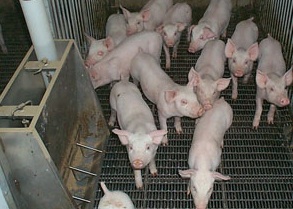
 July 15, 2008, Lincoln, Neb. – Scientists with U.S. Department of Agriculture’s Agriculture Research
July 15, 2008, Lincoln, Neb. – Scientists with U.S. Department of Agriculture’s Agriculture Research
Service and the University of Nebraska – Lincoln recently released research findings that compared nitrogen and
phosphorus availability in field plots receiving inorganic fertilizer,
manure from swine fed traditional corn diets, or manure from swine fed
low phytate corn diets.
July 15, 2008, Lincoln, Neb. – Swine production generates large amounts of manure. While this manure contains nutrients that may serve as fertilizer when applied to agricultural fields, the ratio of nutrients in the waste is different than what a crop requires. Application of manure to meet the nitrogen needs of a crop results in application of excess phosphorus, which increases the potential for environmental contamination. Swine fed corn diets with more highly available phosphorus produce manure that has a nitrogen to phosphorus ratio closer to what a crop needs than swine fed traditional corn diets.
 The use of swine manure for fertilizer has double benefits for the environment. Using swine manure reduces the need for chemical fertilizers for crops and at the same time reduces the amount of manure to be disposed of from swine production. But, when the nutrients in the swine manure don’t match the needs of the crops, the excess nutrients not used by the crops can pollute the soil.
The use of swine manure for fertilizer has double benefits for the environment. Using swine manure reduces the need for chemical fertilizers for crops and at the same time reduces the amount of manure to be disposed of from swine production. But, when the nutrients in the swine manure don’t match the needs of the crops, the excess nutrients not used by the crops can pollute the soil.
Scientists with U.S. Department of Agriculture’s Agriculture Research Service and the University of Nebraska – Lincoln compared nitrogen and phosphorus availability in field plots receiving inorganic fertilizer, manure from swine fed traditional corn diets, or manure from swine fed low phytate corn diets.
Results from the study were published recently in the Soil Science Society of America Journal , a peer-reviewed international journal published six times a year by the Soil Science Society of America.
Researchers found that field application of slurry from low-phytate corn diets at rates needed to meet the nitrogen needs of the crop results in slower accumulation of phosphorus in these soils.
The abstract can be read at http://soil.scijournals.org/cgi/content/abstract/72/4/1096.